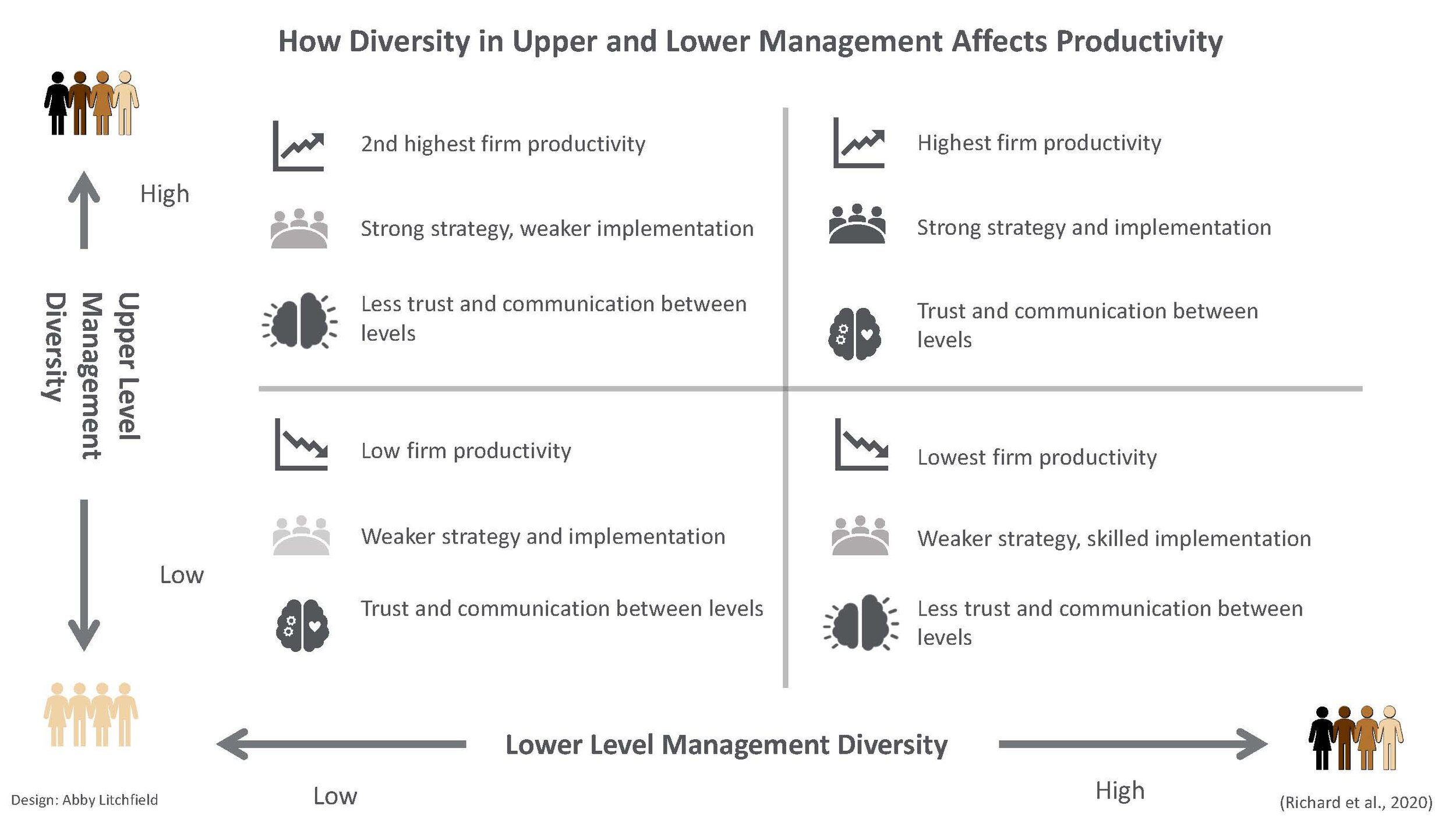Racial diversity in upper and lower management leads to better strategy and implementation — and greater productivity
Diversity results in better decision making. That’s well-known. Diverse groups consider a broader range of ideas and produce more possible solutions.
But additional gains come when diverse employees are located throughout an organization. That’s the insight of groundbreaking research from Orlando Richard (University of Massachusetts Amherst), Maria Del Carmen Triana (Vanderbilt University), and Mingxiang Li (Florida Atlantic University).
Companies benefit most when upper management and lower management are both racially diverse, the researchers found. A 1% increase in racial diversity similarity between upper and lower management increases firm productivity by between $729 and $1590 per employee per year.
The data come from two studies. The researchers first examined all US-based computer companies with more than 100 employees, from 2007 to 2011. They found the $729 per employee benefit. Then they looked at Fortune 500 firms during the same period, finding the even greater benefit.[1]
Why diversity throughout management increases productivity
Diversity in both upper and lower management levels is valuable for several reasons, according to the authors.
First, diversity is a “knowledge-based asset,” with real advantages for strategy and implementation. Diversity leads people to consider multiple perspectives and develop better, more complex approaches.
For senior management, this means greater creativity, innovation, and flexibility in formulating strategy.
For lower-level management, this means better problem-solving in implementation, and more original ideas that they can share with senior management.
Diverse upper and lower management brings another advantage. People identify with others who are like them. Interactions and information exchange become easier.
What if both levels of management aren’t diverse?
Diversity throughout management brings benefits. But upper management, especially, often is not diverse. For example, racial minority employees are 33% of the entry-level workforce, but occupy only 13% of C-suite positions.
Most firms have many more racial minorities in lower management positions compared to senior management.
Here’s how productivity differs depending on where your diverse employees are.
It’s best to have racial diversity at both levels: firms with diverse upper and lower management do better than firms without diversity at either level. Diverse firms’ productivity is 1.32 times higher than firms lacking diversity.
If there’s a mismatch — racial diversity in lower or upper management, but not in both — there’s more advantage to racial diversity in upper management. Firms with high racial diversity in upper management and low racial diversity in lower management outperform those with the reverse dynamic by 2.03.
What’s the added advantage of upper management racial diversity? It likely comes from the benefit for strategy and the novelty (because racial diversity in upper management is so rare, it is even more of a competitive advantage).
Interestingly, even when upper management and lower management are both low on racial diversity, firm productivity is slightly higher than when lower management is high on racial diversity and upper management is low on racial diversity. This may be because there’s less trust between dissimilar levels, and so less information exchange and willingness to act.

What to do if your firm isn’t diverse
Build diversity, the researchers say. Firms that have diversity throughout management levels are already creating competitive advantage. (Recommendations for building diversity are available from Harvard Business Review and a recent NBS article.)
But in the meantime, try to create a culture that values learning from different perspectives. That way, you can capitalize on any diversity you already have, and be well positioned to welcome broadened diversity.
For example:
Hire humble leaders. If firm leaders are modest people who values learning and knowledge while deemphasizing status and position, diverse individuals in lower management are more likely to feel valued and empowered to make recommendations — even if upper management diversity is low.
Create an empowering culture. When lower management feel valued, included, and encouraged to make contributions, they are more likely to speak their minds about what needs to be done in the organization.
Increased diversity means gains for organizations and society. There has always been a moral case for action on diversity. Now, the business case is undeniable as well.
Read the article: Richard, O., Triana, M.d.C., & Li, M. 2020. The effects of racial diversity congruence between upper management and lower management on firm productivity. Academy of Management Journal. 10.5465/amj.2019.0468.
[1] Productivity was measured as revenue divided by number of employees. Racial diversity was assessed with five categories of race (White, African American, Hispanic, Asian, and Native American). “We examine racial diversity rather than other demographics such as gender because research measuring both racial diversity and gender diversity shows stronger effects for race,” the researchers note.



Add a Comment
This site uses User Verification plugin to reduce spam. See how your comment data is processed.This site uses User Verification plugin to reduce spam. See how your comment data is processed.